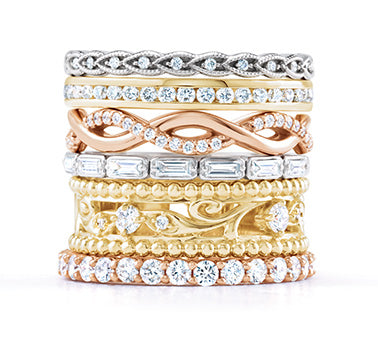Lifetime Warranty
24/7 Hour Customer Service
Free Shipping
30-Day Return
Moijey Fine Jewelry & Diamonds Blog
Why Star Sapphires are Simply Phenomenal
Originally posted on September 29th, 2017
Updated on April 10th, 2020
Last week, I wrote about how sapphires can change colors like alexandrite. The week before, I wrote about padparadscha sapphires (the rarest sapphires in the world). Now I'm focusing on one of my all-time favorite gems: star sapphires.
Cue the angelic choir! Wait, we don't have a choir? Okay then, let's pretend that we have one and revel in the gloriousness of star sapphires.

Aren't these star sapphires gorgeous? It is easy to get lost in their vibrant colors and beautiful star.
Star sapphire is a variety of corundum that displays a phenomenon called asterism. From the Latin Aster, asterism occurs when, reflected by light, tiny needle-like inclusions are arranged in different directions and show a star shape. This demonstration from the Smithsonian describes and explains asterism quite nicely.

How cool is this?
The star (generally composed of rutile inclusions or tiny hollow needles) usually make up either two, three, or six bands to equal four-rayed stars, six-rayed stars, or twelve-rayed stars in a cabochon cut stone. Twelve rayed stars are hard to find, and six-rayed stars are the most common stars.
Like fancy sapphires, star sapphires can occur in all kinds of colors. Also, the most valuable star sapphires are either blue or red, similar to the non-phenomenal varieties of ruby and sapphire. Red and blue are traditionally more expensive than, let's say, purple or yellow. Purple or yellow only become valuable when they have a rich and deep body color and a crisp star. Those standards are usual for star rubies and sapphires.

These are magnificent examples of fancy star sapphires, which are on display at the Smithsonian in Washington, DC.
The red variety is called star ruby, and it was popular in the 1940s and 1950s, a traditional symbol of wealth and success at the time. When the body color is a pure red with a bright and sharp star, it is the most valuable phenomenal ruby in the market. Since a pure red is rare, star rubies appear in a pinkish-red, a purplish red, or a brownish-red. At the Smithsonian, there is a magnificent star ruby on display called the Rosser Reeves Ruby. It weighs 138.7 carats, and the previous owner, Rosser Reeves, used to carry it with him as a good luck charm. The American advertising executive called the gem his "baby."

I can see why this would make an excellent good luck charm.
While star rubies are the most valuable, with the bodycolor deep and the star crisp, black star sapphires are the most affordable. Do you know what else is cool about black star sapphires? They don't have a black body color! Black star sapphires are technically yellow, green, or blue, and the black color comes from hematite inclusions, which cause the black color. Hematite also produces the gorgeous star in a black star sapphire. They're a popular option for men's jewelry, like our 14K Yellow Black Star Sapphire & Diamond Men's Ring, for instance. Quite manly, don't you agree?



Men (and women) can enjoy this majestic and robust ring.
Star sapphires a found in the same places as non-phenomenal sapphires in Sri Lanka, Myanmar, Thailand, Australia, and the US State of Montana. Australia and Thailand provide black star sapphires, and over 90% of star rubies and sapphires are in alluvial (river bed) deposits in Sri Lanka. Myanmar contains the most elegant star rubies and sapphires, but they are in low quantity.
Earlier, I said that star sapphires are one of my favorite gemstones. They're one of my favorites because The asterism phenomenon is relaxing to look at, I've always liked the feel of a cabochon, and the star symbolizes the three qualities of faith, hope, and destiny. Star sapphires are also said to open intuition and helps to center thoughts and assists in anticipating the intentions of other people.

Even in their rough form, star sapphires are gorgeous!
I had a fantastic time writing about sapphires. Now with October around the corner, I'll be writing about opals and tourmaline. That's right, October babies have another birthstone to enjoy!
Why Star Sapphires are Simply Phenomenal
Originally posted on September 29th, 2017
Updated on April 10th, 2020
Last week, I wrote about how sapphires can change colors like alexandrite. The week before, I wrote about padparadscha sapphires (the rarest sapphires in the world). Now I'm focusing on one of my all-time favorite gems: star sapphires.
Cue the angelic choir! Wait, we don't have a choir? Okay then, let's pretend that we have one and revel in the gloriousness of star sapphires.

Aren't these star sapphires gorgeous? It is easy to get lost in their vibrant colors and beautiful star.
Star sapphire is a variety of corundum that displays a phenomenon called asterism. From the Latin Aster, asterism occurs when, reflected by light, tiny needle-like inclusions are arranged in different directions and show a star shape. This demonstration from the Smithsonian describes and explains asterism quite nicely.

The star (generally composed of rutile inclusions or tiny hollow needles) usually make up either two, three, or six bands to equal four-rayed stars, six-rayed stars, or twelve-rayed stars in a cabochon cut stone. Twelve rayed stars are hard to find, and six-rayed stars are the most common stars.
Like fancy sapphires, star sapphires can occur in all kinds of colors. Also, the most valuable star sapphires are either blue or red, similar to the non-phenomenal varieties of ruby and sapphire. Red and blue are traditionally more expensive than, let's say, purple or yellow. Purple or yellow only become valuable when they have a rich and deep body color and a crisp star. Those standards are usual for star rubies and sapphires.

These are magnificent examples of fancy star sapphires, which are on display at the Smithsonian in Washington, DC.
The red variety is called star ruby, and it was popular in the 1940s and 1950s, a traditional symbol of wealth and success at the time. When the body color is a pure red with a bright and sharp star, it is the most valuable phenomenal ruby in the market. Since a pure red is rare, star rubies appear in a pinkish-red, a purplish red, or a brownish-red. At the Smithsonian, there is a magnificent star ruby on display called the Rosser Reeves Ruby. It weighs 138.7 carats, and the previous owner, Rosser Reeves, used to carry it with him as a good luck charm. The American advertising executive called the gem his "baby."

While star rubies are the most valuable, with the bodycolor deep and the star crisp, black star sapphires are the most affordable. Do you know what else is cool about black star sapphires? They don't have a black body color! Black star sapphires are technically yellow, green, or blue, and the black color comes from hematite inclusions, which cause the black color. Hematite also produces the gorgeous star in a black star sapphire. They're a popular option for men's jewelry, like our 14K Yellow Black Star Sapphire & Diamond Men's Ring, for instance. Quite manly, don't you agree?



Men (and women) can enjoy this majestic and robust ring.
Star sapphires a found in the same places as non-phenomenal sapphires in Sri Lanka, Myanmar, Thailand, Australia, and the US State of Montana. Australia and Thailand provide black star sapphires, and over 90% of star rubies and sapphires are in alluvial (river bed) deposits in Sri Lanka. Myanmar contains the most elegant star rubies and sapphires, but they are in low quantity.
Earlier, I said that star sapphires are one of my favorite gemstones. They're one of my favorites because The asterism phenomenon is relaxing to look at, I've always liked the feel of a cabochon, and the star symbolizes the three qualities of faith, hope, and destiny. Star sapphires are also said to open intuition and helps to center thoughts and assists in anticipating the intentions of other people.

Even in their rough form, star sapphires are gorgeous!
I had a fantastic time writing about sapphires. Now with October around the corner, I'll be writing about opals and tourmaline. That's right, October babies have another birthstone to enjoy!






